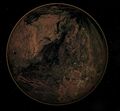Difference between revisions of "Carbon planet"
m |
Daedalus-01 (talk | contribs) m |
||
| (One intermediate revision by the same user not shown) | |||
| Line 2: | Line 2: | ||
[[Image:060607_planet_compare_02.jpg|thumb|right|Comparison between a normal planet and a carbon planet.]] | [[Image:060607_planet_compare_02.jpg|thumb|right|Comparison between a normal planet and a carbon planet.]] | ||
Carbon planets are predicted to be of similar diameter to silicate and water planets of the same mass, potentially making them difficult to distinguish.<ref>[http://arxiv.org/abs/astro-ph/0504214 Extrasolar Carbon Planets]</ref> | Carbon planets are predicted to be of similar diameter to silicate and water planets of the same mass, potentially making them difficult to distinguish.<ref>[http://arxiv.org/abs/astro-ph/0504214 Extrasolar Carbon Planets]</ref> | ||
==Formation== | |||
For carbon planets to form, it would be necessary for the protoplanetary disc of the host star to be carbon-rich, and oxygen-poor. Such stars exist near the center of our galaxy.<ref>[http://journals.cambridge.org/action/displayAbstract;jsessionid=4F80092E789D72629FBB26FA9AA23D76.tomcat1?fromPage=online&aid=2373008 Carbon-rich AGB stars in our Galaxy and nearby galaxies as possible sources of PAHs]</ref> As stars age, they tend to produce more carbon, and as the interstellar medium is enriched with heavier elements through the deaths of old stars, carbon planets may become more common as the universe ages.<ref>[http://www.astronomyforum.net/planetary-forums/88245-carbon-worlds-carbon-rich-planets.html Carbon Worlds -- Carbon-rich Planets]</ref> | |||
==Gallery== | ==Gallery== | ||
| Line 13: | Line 16: | ||
<references /> | <references /> | ||
[[Category:Astronomy]] | |||
[[Category:Science]] | [[Category:Science]] | ||
Latest revision as of 16:30, 5 February 2012
Carbon planets are a theoretical type of terrestrial planet that form in carbon rich (and oxygen poor) protoplanetary disks. The core would be iron rich and surrounded by silicon carbide and titanium carbide. The mantle would be mainly made of graphite and multi-kilometer thick layer of diamond (if there is sufficient pressure.[1] The surface would be abundant in hydrocarbons and carbon monoxide.
Carbon planets are predicted to be of similar diameter to silicate and water planets of the same mass, potentially making them difficult to distinguish.[2]
Formation
For carbon planets to form, it would be necessary for the protoplanetary disc of the host star to be carbon-rich, and oxygen-poor. Such stars exist near the center of our galaxy.[3] As stars age, they tend to produce more carbon, and as the interstellar medium is enriched with heavier elements through the deaths of old stars, carbon planets may become more common as the universe ages.[4]



